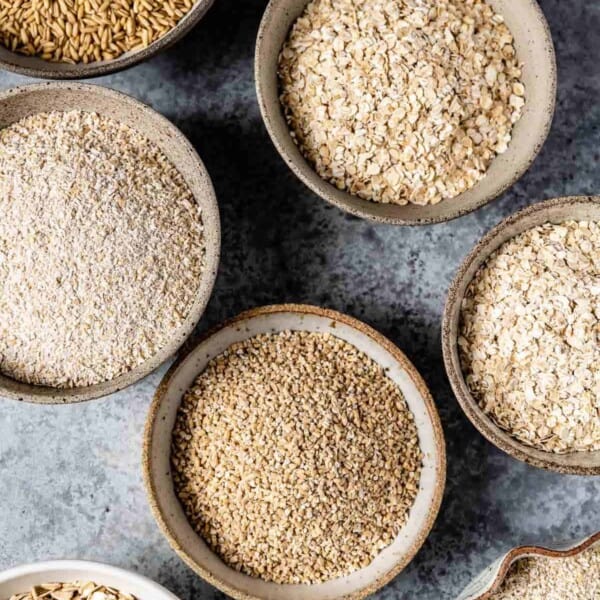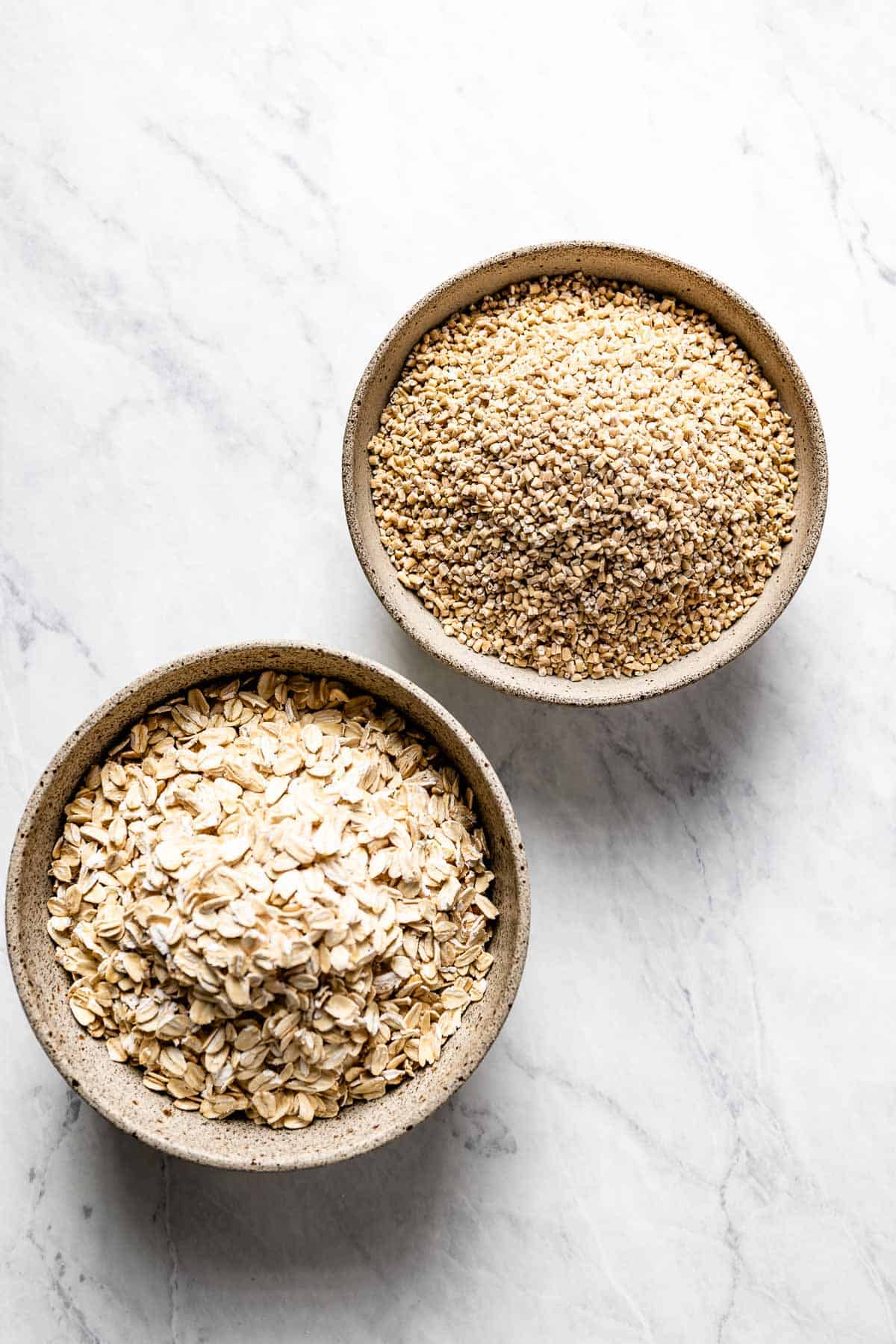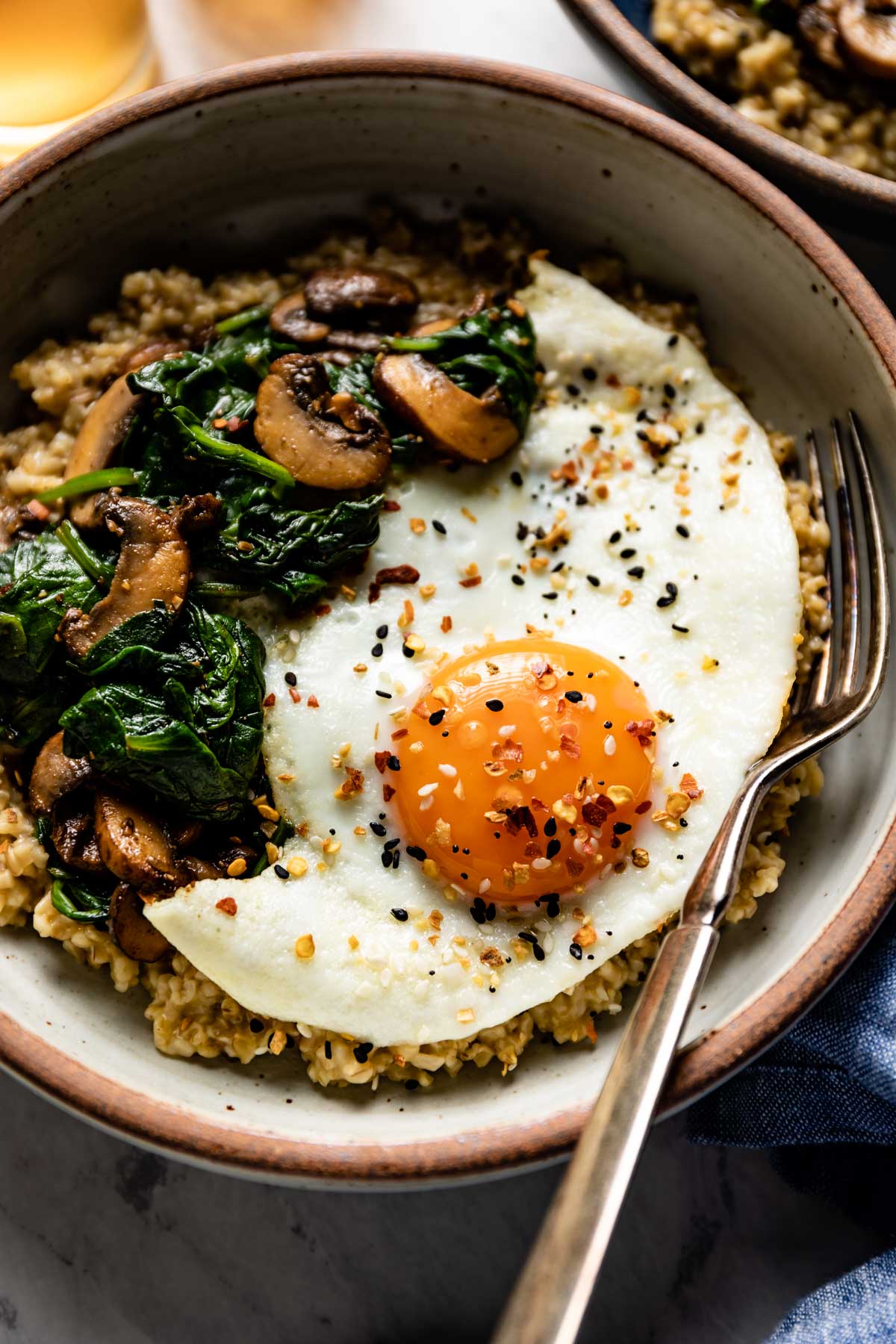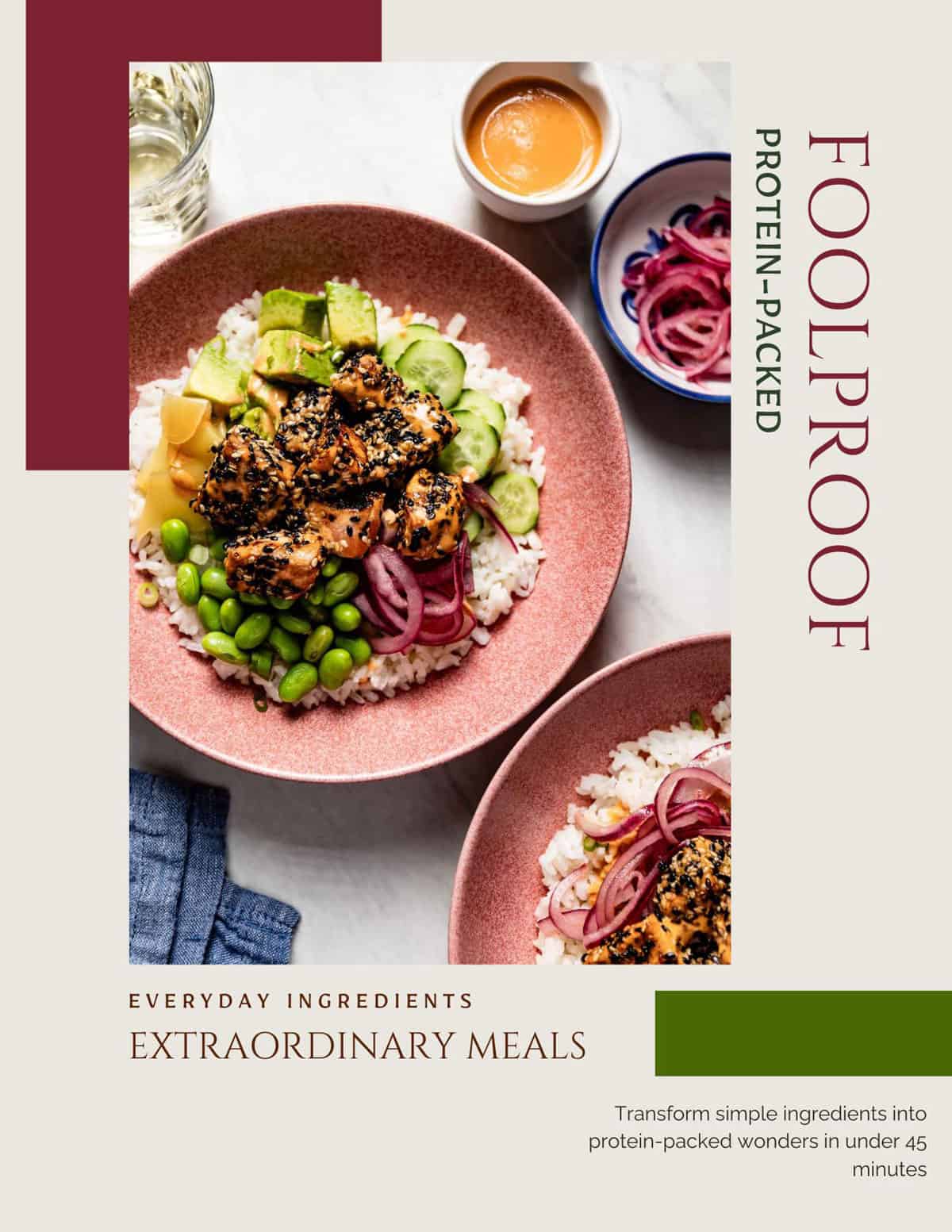Oats have a wonderful reputation for being a heart-healthy breakfast with plenty of fiber, vitamins, minerals, and antioxidants. But because this whole grain comes in so many different shapes and sizes, it’s important to distinguish one from the other.
Whether you want to discover the difference between types of oatmeal or names of oats, this ultimate guide will get you started. And if you are a big oat lover, be sure to check out our other posts on the subject: the difference between steel-cut oats and regular oats and quick oats vs. rolled oats.
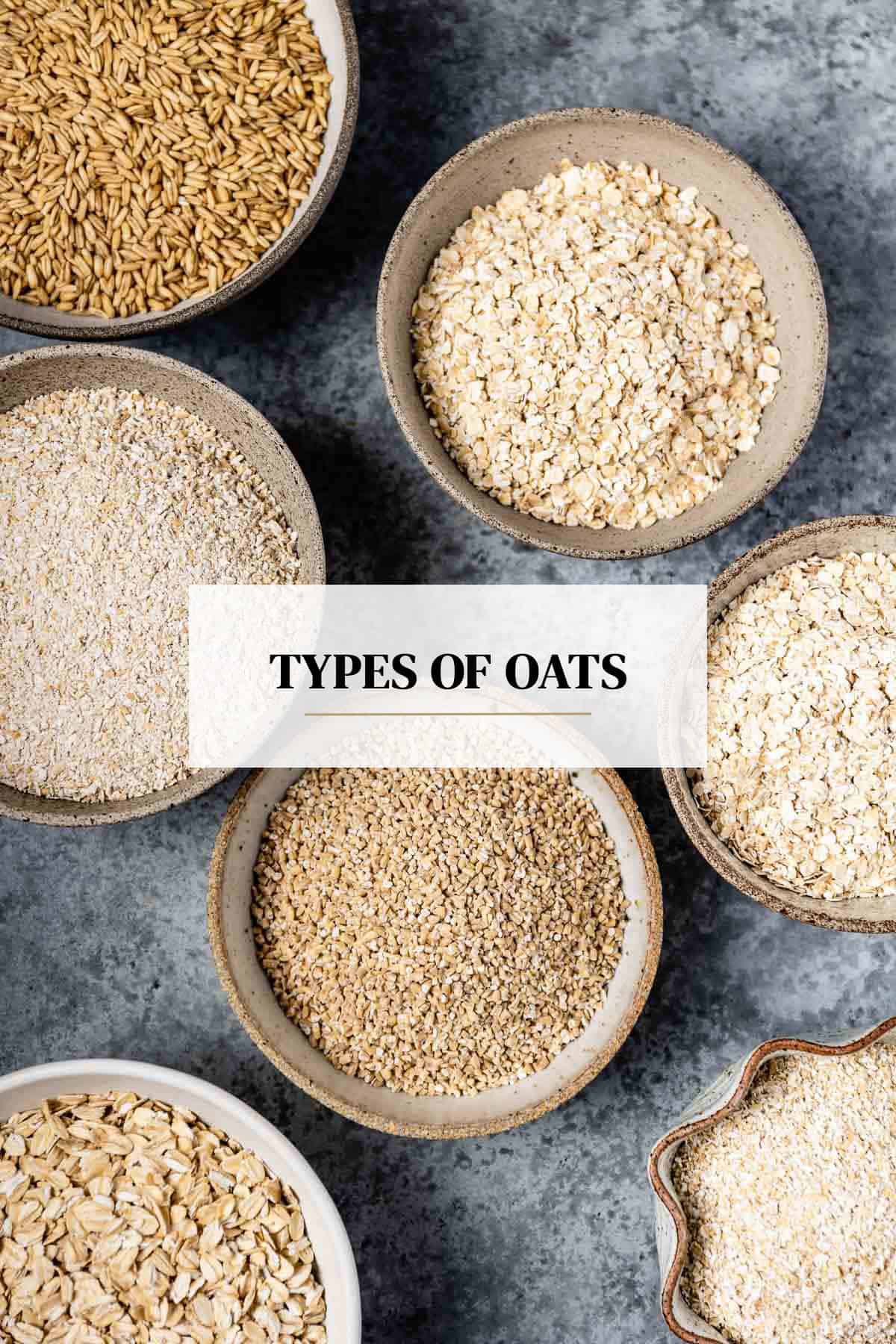
How Are Oats Made?
Unprocessed oats originate from the cereal plant known as Avena sativa. This cereal grain is grown for its seed, with the stalks and inedible hull attached. Once these stalks and hulls (outer layer) are removed, it becomes what we know and recognize as whole oat groats.
The impressive health benefits of oats have much to do with the fact that it is a whole grain, with the bran, endosperm, and germ still intact. All these parts combined contribute to oats’ high amounts of fiber (most notably beta-glucan), vitamins, minerals, and antioxidants.
Once processing and manufacturing take place, that’s when the oat groats become their varying cut and/or steamed counterparts. Each difference in manufacturing alters the taste, texture, and cooking process. As a result, cooked oats, also known as oatmeal, vary in texture and taste depending on the kind of oats used.
Oats are naturally gluten-free. However, they are often processed in facilities that also process wheat and barley, both of which are gluten-containing grains. Therefore, if you are following a gluten-free diet, it is important to check the packaging to ensure that they are certified gluten-free.
Different Types of Oats
With so many different types of oats on grocery store shelves, it’s important to know the difference between them so that you can be a master of oats and even experiment with different kinds of oatmeal with ease. Let’s discover the unique characteristics of each cut of this whole grain.

Whole Oat Groats
Whole Oat Groats (Oat Kernels / Oat Berries) is a cereal grain in its whole form and the least processed form of oats. Although popular in many health food stores, this one takes the longest to cook, with a cooking time of about 30-45 minutes. Because of this, many recipes feature whole oat groats made in the Instant Pot or slow cooker. Thanks to their nutty and chewy texture, they are a great choice for savory dishes like grain salads or risotto.
Steel Cut Oats / Irish Oats
Steel Cut Oats (Irish Oats / Irish Oatmeal) are just as the name suggests. They are whole oat groats that have been cut into 2-4 smaller pieces with steel blades. This allows more water to penetrate into the oat kernels, resulting in a chewier texture and a shorter cooking time (compared to Whole Oat Groats), about 20-30 minutes.
However, you can shorten the active cooking time by using different techniques such as soaking them overnight as I did with this Steel Cut Overnight Oats recipe or cooking them in an instant pot like in this Steel Cut Oats in a Pressure Cooker recipe, or even letting the slow cooker do most of the work for you as I did in this Overnight Slow Cooker Steel Cut Oats recipe.
Alternatively, you can also use it in savory dishes like my Savory Steel Cut Oats for a healthy and satisfying meal. With a rich and nutty flavor, steel-cut oatmeal is perhaps one of the most satisfying breakfasts you can make for yourself.
That being said, even though a bowl of steel-cut oatmeal is a delicious meal, I do not recommend them for baking recipes like granola bars, baked goods, or muesli because of its long cooking time.
Scottish Oats
Scottish Oats are whole oat groats that have been stone ground to create milled oats of varying shapes and sizes. Although not too common here in the United States, it has been the traditional Scottish breakfast for quite some time. With a unique texture and flavor, Scottish oats are mostly used in porridge (aka hot cereal) and oatcakes. They take about 10 minutes to cook on the stove top and can also be prepared in the microwave.
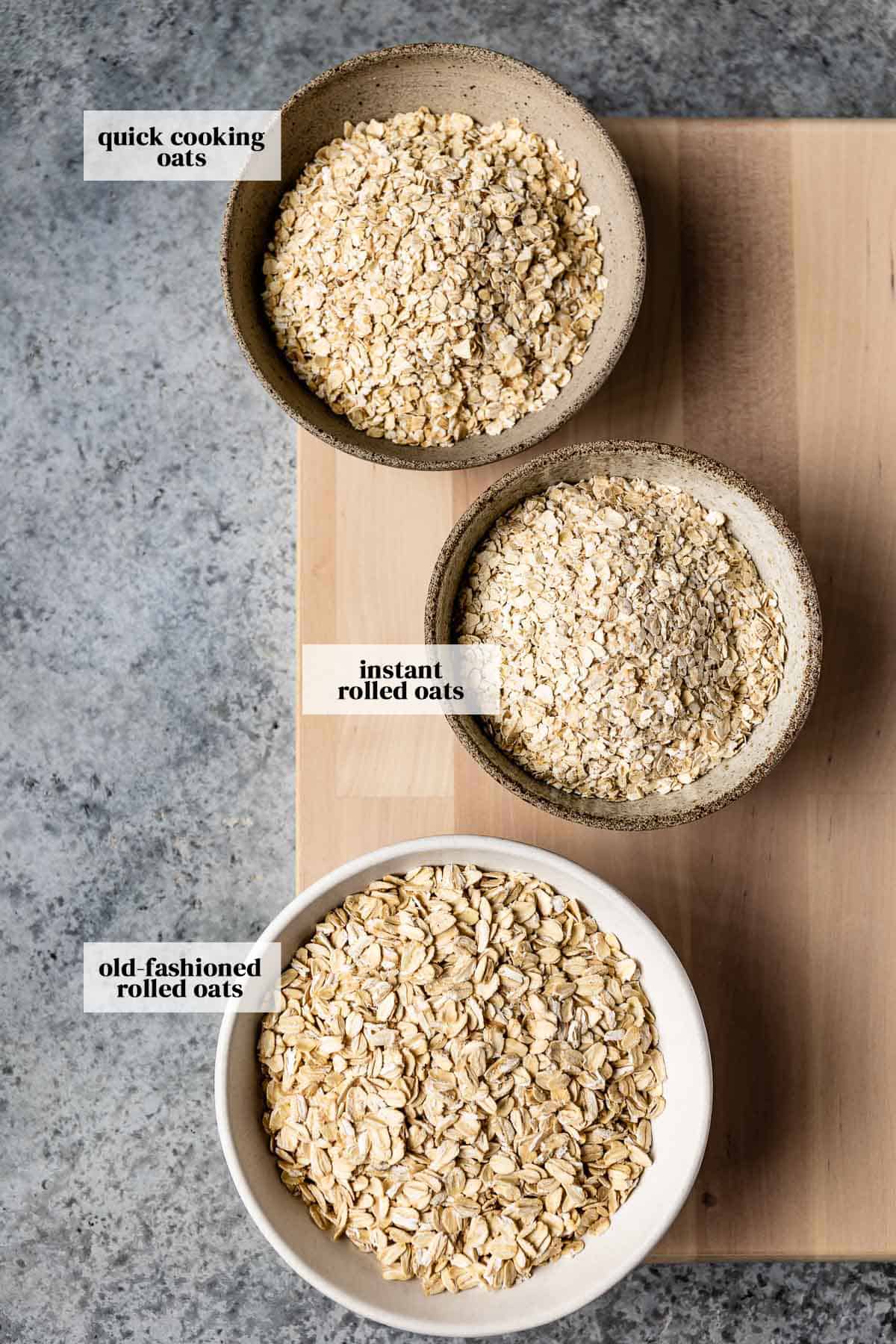
Rolled Oats / Old-Fashioned Oats
Whether you call them Rolled Oats, Old Fashioned Oats or Regular Oats, these are by far the most popular variety of oats on the market. These are made by first steaming the whole oat groat and then rolling them flat with steel rollers. This rolling process stabilizes oils in the grain, creating a longer shelf life and shorter cooking time, which makes them a pantry staple for many. Thickness varies based on brand, with thicker oats contributing to a chewy texture.
Since they are Incredibly versatile, rolled oats can be used in so many different applications, including Almond Milk Oatmeal, Baked Oatmeal with Dates, Cinnamon Apple Oatmeal, Greek Yogurt Overnight Oats, Overnight Muesli, Oatmeal Raisin Cookies, and Homemade Granola.
Quick Oats
Quick Oats take processing a step further. They are rolled oats that have been steamed and then rolled thinner, sometimes chopped into smaller pieces. Because they are thinner, this creates a greater surface area, and as a result, the cooking time is much shorter. A quick 1-3 minute zap in the microwave and quick-cooking oats are ready for consumption.
With that being said, you can get away from cooking them if you let them soak for a few minutes in your choice of liquid (milk, water, juice, etc.) That is why, I use quick oats in my Homemade Muesli recipe (aka breakfast cereal.)
Instant Oats
Instant Oats are the most processed of the whole oat kernel. Once steamed and rolled thin, instant oats are precooked, dried, and then cut into even smaller pieces. As the name suggests, instant oatmeal cooks in an ‘instant’ after only a quick soak in hot water or a 1-minute cook time in the microwave.
Since instant oats appear in many processed foods, it’s important to steer clear of those with added sugars or preservatives, as this simply negates the health benefits of oats. If you are in need of instant oats, ‘oats’ should be the only ingredient on the label.
Oat Bran
Oat Bran is the outer layer of the whole oat kernel. Technically speaking, it is not a whole grain since it does not contain the endosperm or germ, but it is celebrated for its high fiber content. Oat bran makes a wonderful addition to porridge, cereal, smoothies, or baked goods if you are looking to increase your fiber, but keep in mind that too much oat bran will alter the final texture.

Oat Flour
Oat Flour is basically rolled oats that have been ground into a fine powder. It is also a gluten-free flour that is high in fiber and protein. A wonderful addition to baked goods, oat flour can be used as a thickening agent as well. If you own a food processor, you’re in luck and can make homemade oat flour whenever the recipe calls for it.
Types of Oats Appearance and Texture
The appearance and texture of whole oats vary based on the cut and style. Here they are broken down into a handy chart:
| Type of Oat | Looks Like | Texture | Cook Time on Stovetop |
|---|---|---|---|
| Whole Oat Groats | Rice, Barley | Grain Pilaf | 30-45 minutes |
| Steel Cut Oats | Rice cut into pieces | Toothsome, Chewy | 20-30 minutes |
| Scottish Oats | Coarse meal | Rich, Creamy | 10 minutes |
| Old Fashioned (Rolled Oats) | Flat, irregularly round flakes | Creamy, Chewy | 5-10 minutes |
| Quick Oats | Coarsely chopped, thinner flakes | Mushy | 1-3 minutes in the microwave |
| Instant Oats | Very thin, small chopped flakes | Very Mushy | 1-minute hot water soak or microwave |
| Oat Bran | Brown, very thin flakes | Creamy, Chewy | 3 minutes |
| Oat Flour | Slightly beige, fine flour / powder | Soft, Tender | Varies – based on use / application |
Nutrition Information for Most Common Kinds of Oats
The nutritional value of oats varies based on manufacturing. According to Nutrition Value, here are their key nutrition facts broken down in the table below:
Note: The nutritional values below are based on Bob’s Red Mill brand. The values below are for reference only and may change based on the brand and amount you use. As always, refer to your preferred nutrition calculator.
| Nutrition Facts per 2 oz (56 grams) | Whole Oat Groats | Steel Cut Oats | Scottish Oats | Rolled Oats | Quick Oats | Instant Oats |
|---|---|---|---|---|---|---|
| Calories | 227 | 219 | 221 | 221 | 227 | 230 |
| Protein | 6.3 g | 6.4 g | 9.5 g | 7.4 g | 7.6 g | 7.1 g |
| Carbs | 43 g | 40 g | 36 g | 40 g | 40 g | 41 g |
| Fiber | 6.3 g | 6.5 g | 6.3 g | 6.3 g | 5.1 g | 5.3 g |
| Net Carbs | 36.7g | 33.5 g | 29.7 g | 33.7 g | 34.9 g | 35.7 g |
| Fat | 3.2 g | 3.2 g | 3.9 g | 3.7 g | 3.8 g | 4.4 g |
| Sugar | 0 g | 1.3 g | 0 g | 1.1 g | 0 g | 0 g |
Nutritional Value resources are: Steel Cut Oats, Rolled Oats, Quick Cooking Oats, Whole Grain Oat Groats, Scottish Oats, Instant Rolled Oats.
FAQs
Steel-cuts oats and Scottish oats are considered the healthiest as these are the least processed and have the lowest net carbs and effect on your blood sugar.
Modern oats originate from the cereal grain known scientifically as Avena sativa. They are primarily grown in North America and Europe.
Oats refer to uncooked whole grain, while oatmeal refers to the porridge-like dish that results from cooking in water, milk, or plant-based milk such as Almond Milk.
Rolled oats and old-fashioned oats are the same things. Oftentimes the terms are used interchangeably.
Quaker oats is the brand. Their product line contains rolled oats, along with steel-cut oats, quick oats, instant oats, and bran cereal.
Both steel-cut and rolled oats are whole grain as they are made from the whole oat kernel, which includes the bran, endosperm, and germ.
According to Healthline, it is safe to eat rolled oats raw since they have already been heated during the manufacturing process. But raw oats should be soaked in some sort of liquid or milk prior to consumption to improve digestibility and nutrient absorption.
